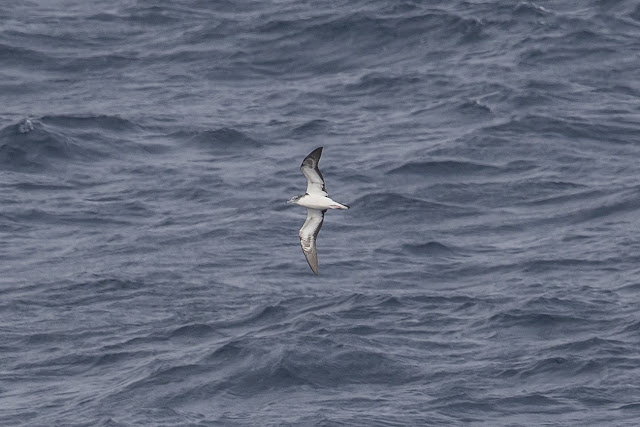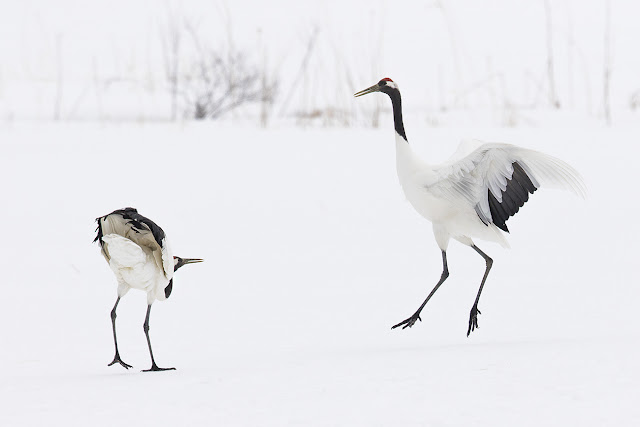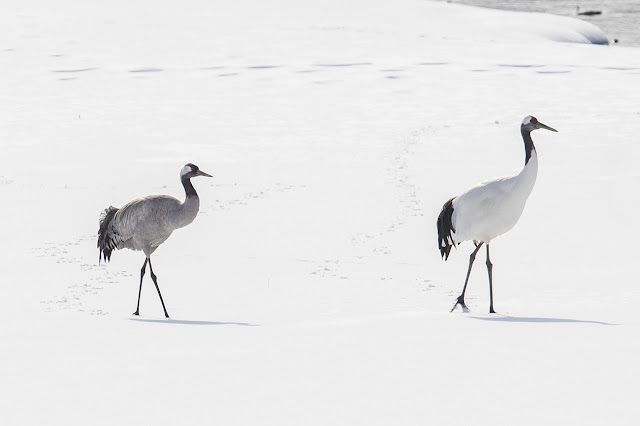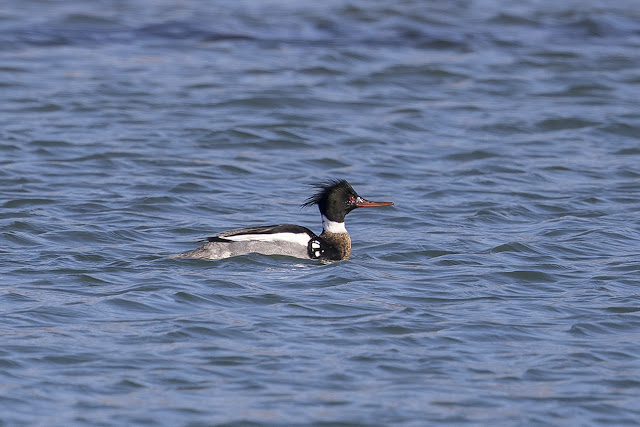Red-crowned Crane - key species of Hokkaido
Captain had talked about going on a trip to Hokkaido for more than a year, we finally got together a group of 12 for a 9 days trip for a winter birding experience. Hokkaido is likely considered one of the top sites anywhere in Asia for winter birding, the number of species that you can find during the harsh winter months are surprising, with impressive species such as Steller’s Sea Eagles, Red-crowned Cranes and Blakiston’s Fish Owls, to smaller winter visitors such as Snow Buntings and numerous Sea Ducks, the list of possible goodies goes on and on!
As one of the 12 members on the trip, I gladly followed the itinerary decided by Captain (I barely did any pre-trip studying for this trip). Our original plan was to fly from Hong Kong to Tokyo and take a train to Oarai, where we will board an overnight ferry towards Tomakomai and look for sea birds along the way. Then, we will rent a car and drive from Tomakomai to Kushiro and up towards the crane sanctuary at Tsurui, after that we will travel East towards Lake Furen and up towards Rausu before we head back to Tomakomai to catch a ferry back to Tokyo. That was the plan anyway...I shall leave the full story in my report that follows.
I don’t have much birding experiences in sub-zero conditions, so I was slightly nervous about how the cold would affect my ability to bird, I probably packed more clothes than I needed, but better be safe than sorry!
Day 1:
On the 3rd of March we met up at the airport and boarded a morning flight to Narita Airport. The crew consisted of myself, Captain, Yuen and Nikki, Peter and Michelle Wong, Alfee and Hailey, Dickson Wong and Francis Yu, while Brother Kei and his wife arrived in Tokyo a day earlier and met us at Narita Airport directly.
The flight was not particularly eventful, other than a distant view of Mt Fuji from the plane.
Mt Fuji from the air
We arrived at Narita ahead of schedule and Brother Kei met us at the airport. We took a bus from Narita towards Mito where we planned to take another bus towards Oarai, however none of us spoke Japanese, making finding the right local bus a difficult task...In the end we took a train towards Oarai, despite the fact that we had to walk 20 minutes from the JR station to the ferry port. With the aid of Google maps we found the ferry port with little effort.
JR Mito Station
Train from Mito to Oarai
Oarai - location to board the Sunflower passenger liner
The Sunflower Ferry sails from Oarai to Tomakomai directly, with a total sailing time of 18 hours, there are two departure time to choose from daily, one during the day while the other at 1:30am. We chose to latter as it gives us more daylight hours during the trip to scan for seabirds. They managed to fit the entire group into one large room. We seemed to be the only group of tourists onboard, otherwise I counted no more than 30 passengers, I guess winter is the low season for tourists heading up to Hokkaido. The ship was not huge, but pretty decent size with basic amenities, a small dining room and sitting area as well as a public Japanese style bathroom. While the cruise was not specifically birding orientated, previous reports from this ferry line indicates that there are chances of a good seabirds that one may encounter onboard, including Layson’s Albatross or other Shearwaters and Auklets.
Common area onboard Sunflower Sapporo
We settled in for the night, hoping to wake up early the next day for a full day of seabird watching!
Day 2:
I woke up at 6:30am to a glorious morning, Black-tailed Gulls were already visible from the cabin window. I quickly got dressed and headed out to the viewing deck. Others soon joined me, scanning the sea for seabirds. We managed to catch a glimpse of the southbound Sunflower ferry early morning.
Southbound ferry
coastline around Kinkasan
Black-tailed Gulls were numerous, we saw hundreds following smaller fishing boats, while similarly sized Mew Gulls were less common, but their white tails makes them easily recognisable in amongst the Black-tailed Gulls.
Black-tailed Gull
Mew Gull
Black-legged Kittiwake - adult winter plumage
Black-legged Kittiwake - 1st year
Slaty-backed Gulls were regularly sighted, while a single 1st year bird also made an appearance. We encountered very few large gulls, perhaps they weren't as pelagic as the other species.
Slaty-backed Gull
Slaty-backed Gull - 1st year
Streaked Shearwater
Sooty Shearwater
A Pacific Diver and A single Red-necked Grebe were a bit of a surprise. Views were extremely brief but we got some recognisable views none the less.
Pacific Diver
Red-necked Grebe
As we sailed further north, we passed by Ancient Murrelets in their hundreds, we scanned for Japanese Murrelets but was unsuccessful. It was fun however to see these birds bounce off the water as they fluttered off clumsily.
Ancient Murrelet
One of the best find was probably 2 medium morph Northern Fulmars of the race rodgersii. Having only seen very pale Fulmars in the UK, I did not recognise them at first as they looked so different!
Northern Fulmar - rodgersii
As our ship sailed through the Tsugaru Straits between Honshu and Hokkaido, Ancient Murrelets were replaced by large flocks of over Crested Auklets, which got everyone quite excited as this was the first auklet species for most of us!
Crested Auklet
Other than birds, we also sighted a few sea mammals, including a species of whale which was likely a Minke Whale, a large pod of Dall’s Porpoise plus a few Northern Fur Seals.
Dall's Porpoise
Northern Fur Seal
Temperature dropped significantly as we sailed further north, we decided to retreat back into the warm comfort of the cabin. Although we did not manage to find anything hugely impressive, we were pretty happy with the list of seabirds we got.
Fighting the cold...
The ship arrived at Tomakomai around 7:45pm, although it took a while before we were able to get off. From the ferry port we got our 3 rental cars and headed to the hotel. All cars were fitted with snow tires, but driving in icy condition was completely new to me, we were all quite cautious as we drove to our hotel.
Day 3:
I woke up to the view of white rooftops and lawns from our hotel window. After a simple Japanese style breakfast we began our long drive towards Tsurui. We took mainly toll roads, the quickest and probably safest route by car as they were better maintained, although it was not particularly cheap, setting us back over 5000yen per car!
We got off the highway and drove towards Tsurui, as soon as we got near the area we were greeted by a few Red-crowned Cranes resting on a snow covered field next to the road. We got out and enjoyed brilliant views of two adults with an immature bird. Along the way we saw a few more Cranes, a pair even performed their elegant mating rituals right in-front of us! The dancing cranes provided plenty of good photographic opportunities for everyone.
Red-crowned Crane - courtship dance
Yuen spotted a single White-tailed Eagle perched on top of a tree by the road, they turned out to be surprisingly common in Hokkaido, but impressive to look at none the less. We tried to have lunch in a small cabin restaurant by the main road but with little success, based on our limited Japanese we figured that the owner simply could not handle more than 12 people in the restaurant. We added Marsh Tit onto our list as we observed the birds on the bird feeder outside the restaurant.
White-tailed Eagle
Marsh Tit
Having failed to find a suitable lunching spot we decided to first head towards a roosting site known for a Ural Owl; one of our key target bird of the trip. The owl was easily found after a short trek into a snow covered forest track. Everyone enjoyed excellent views of this beautiful creature. We even managed to caught up with Yann Muzika there, who gave us a few pointers of the birds he had seen recently, including a site where he had seen a Long-tailed Rosefinch the day before.
Ural Owl
Since that particular location was just 5 minutes drive away we decided to try our luck, we were however discouraged by the deteriorating weather as the snow got heavier, so all we could do was head for lunch. Most restaurants in the area closed after 2pm, so we were very happy that the restaurant in the Kushiro Marsh Observatory was opened for business.
Before we headed to our hotel in Kushiro, we stopped at Tsurumidai to look at more Cranes. There are a few privately run crane feeding stations in the area, however this government opperated station was free of charge, most of the tourists had already gone when we arrived, so we had the whole place to ourselves. The cranes were extremely photogenic whichever angle you looked at them, we spent over half and hour enjoying this magnificent sight. Like most cranes, the Red-crowned Crane is an endangered species, with just around 2,000 individuals globally. The resident population in Japan make up for half of the world’s population, therefore globally extremely important.
Red-crowned Crane - key species at Tsurumidai, Tsurui
Other than the cranes, there were a few Whooper Swans there. I never realise how large they were, only when you compare them side by side with the cranes do you realise they were just as big! If not even chunkier, the only thing they lacked were the long legs.
Whooper Swan
We drove back to the Route Inn in Kushiro, where we enjoyed an excellent shabu-shabu dinner.
Day 4:
We began our day by driving back towards Tsurui, hoping to find the Long-tailed Rosefinch. On the way we passed by Nakasetsuri, a bridge famous for the view of cranes resting and feeding by the river early morning. The view was simply poetic, as cranes dotted around the edge of the icy river.
View from Nakasetsuri
A few cranes were feeding very close to the bridge, under the morning sun they were simply stunning to look at.
Red-crowned Crane
Just as we were about to leave I spotted a rather dark looking Crane in the distant, with a better look I was able to positively identify the crane as a Common Crane, slightly smaller and greyish overall. Common Cranes should be wintering much further south, therefore this stray bird no doubt is considered a vagrant here.
Common Crane & Red-crowned Crane
We arrived back at the Long-tailed Rosefinch location under glorious weather. However, the heavy snow the day before seemed to have covered up most of the field which finches had fed on according to Yann’s description. We were only able to get a fairly close views of an adult Steller’s Sea Eagle on a tree nearby. They are definitely one of the key species to find in Hokkaido, this huge eagle is listed as vulnerable on the red list. Supposedly one of the heaviest species of Eagle in the world, weighing up to 9kg, with wing-span reportedly up to 2.5m...it's a massive bird!
Steller's Sea Eagle
Yuen announced that he spotted the Rosefinch further down the road, we were however unable to relocate it despite much effort, only a few Brown-eared Bulbuls were seen. The only consolation was a male Lesser Spotted Woodpecker which showed fairly well.
Brown-eared Bulbul
Lesser Spotted Woodpecker
Next to a barn, we were surprised to find two Red-crowned Cranes feeding with the cattle. They were obviously used to people and we were able to get really close to them.
Red-crowned Crane - sharing food with cattles
Since we were close-by, we decided to visit the Ural Owl one more time before we left. The Owl showed much better under the better lighting and was slightly more ‘showy’, occasionally scratching and preening.
Ural Owl
We left the owl at peace and continued on our journey towards to coast, along the way we spotted a Red Fox crossing the road, they are probably one of the most common mammal in the harsh Hokkaido winter.
Red Fox
From there we drove eastwards towards Cape Kritappu. After a seafood lunch at Akkeshi, we stopped briefly at the fishing port of Akkeshi Bay and added a few species like Red-breasted Merganser, Common Goldeneye, Black-headed Gull and Eurasian Wigeon.
Red-breasted Merganser - male
Common Goldeneye - male
Slaty-backed Gulls were very common here and were amazingly confiding, a few even perched on a fishing boat as the fisherman did his thing...They were probably used to getting free handouts from people, as was a few Carrion Crows which obviously came closer to 'check us out'. Whooper Swans were quite numerous here.
Slaty-backed Gull
Carrion Crow
Whooper Swan
We left Akkeshi and followed route 123 towards Hichirippu, where we stopped briefly and added a flock of Harlequin Ducks, a species that was far more common in Hokkaido than I expected! An adult drake was particular impressive. A few Red-breasted Mergansers at closer quarters were also found along the bay.
Harlequin Duck
Red-breasted Merganser - male
Red-breasted Merganser - female
Our next stop was the seashore of Biwase, overlooking the Kenbokki Island. We were there to find Brent Geese and we were not disappointed, as we immediately picked up a few amongst the Whooper Swans. They seemed to be following the Whooper Swans as their longer necked cousins were able to pull kelp from the sea floor while they picked up the leftovers. Black Scoters were numerous here, but we saw no other species of sea ducks despite constant scanning.
Brent Goose
Black Scoter
We drove towards Cape Kritappu afterwards, stopping at a supposed location for Asian Rosy Finch. The finches were supposed to frequent a residential garden, but the owner of the house is notoriously hostile towards passing birders. So, we only stayed in our car as we scanned the area but had very little luck. We gave up soon when an angry man stormed at us holding some kind of metal bar...a clear sign for us to take off! Cape Kritappu was stunning in the setting sun, but it was also bone chillingly cold, with strong wind whipping through the headland at immense force. Seeing that we ran out of sunlight, we decided to call it a day and started our drive towards Lodge Furen, our accommodation for the coming two nights.
View from Cape Kritappu
It started snowing heavily, so the journey took much longer than expected. It was already quite late when we arrived at the lodge, where Matsuo San greeted us and showed us around. The lodge was very homely, and Matsuo San prepared a very delicious home cooked meal for us. He briefed us on a few possible birding locations we could visit the next day.
Inside Lodge Furen



























































































Lodge Furen - nice breakfasts ! Great to see the seabirds visible from the ferry ...
ReplyDeleteYes, will certainly return there in the summer, I heard better birds to be seen on the ferry in summer as well...
DeleteHi, I'm planning to go to East Hokkaido in January next year. Can you tell me in Kushiro where is the place to see Ural Owl?
ReplyDeleteAnd how did you make booking for Lodge Furen? I emailed them but no reply.
Hi, the various birding spots and locations can be found in this link: http://gamebirds.me/2016/04/06/textbook-trip-hokkaido/
DeleteWe booked through email, Matsuo San can be a bit late in replying emails sometimes...
This comment has been removed by a blog administrator.
ReplyDelete👍👍👍
ReplyDeleteKwan
Thanks for sharing your experience. Can you pls let me know the location of the ural owl?
ReplyDeleteHi Chuin Ming Lee, the Ural Owl's location is well known amongst birders there, we found the location from this blog : http://gamebirds.me/2016/04/06/textbook-trip-hokkaido/
DeleteHappy Birding~
Excellent report and very useful pointers for first timer birders in Japan. Thanks for sharing.
ReplyDelete